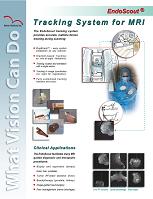The EndoScout Tracking System

Calculates the Location and Orientation of Miniature Sensors
The EndoScout system enables tracking of the location and orientation of miniature sensors during an MRI scan (for more information about the sensors click here). The tracking is based on the native gradient fields of the MRI scanner, thus there is no need to register the tracking system to the scanner before each use. The system can be easily installed and used on any scanner, with no need to modify the scanner or its mode of operation and with no electromagnetic interference.
The EndoScout is FDA cleared for any MRI-guided intervention on MRI scanners. It is being used for various clinical procedures on open scanners (prostate brachytherapy and cryotherapy, RF ablation of liver tumors, cryotherapy of renal cancer, breast biopsy, brain surgery and more) and for research on close-bore scanners (MRI catheterization and endoscopy, motion artifact elimination) in leading clinical centers around the globe.
Clinical Applications
The EndoScout facilitates many MR-guided diagnostic and therapeutic procedures:
- Biopsy and aspiration (breast, brain, liver, prostate).
- Tumor RF/laser ablation (liver).
- Brachytherapy (prostate, kidney).
- Image-guided neurosurgery.
- Pain management (nerve blockage).
Specifications
- Realtime 6 degrees-of-freedom tracking during MR imaging with FSE, FGRE, SPGR, SSFSE.
- Number of Tracking Devices: 2 out of 4 ports.
- Tracking Accuracy: Location: 2mm, Orientation: 1 degree (values represent 2 standard deviations of the tracking error population).
- Tracking Range: Up to 30cm from the center of the scanner.
- Tracking Angle: Unlimited (360 degrees).
- Tracking Rate: Up to 16Hz.
- Input Power: 120VAC/0.8A (60Hz) or 230VAC/0.4A (50Hz).

Mode of Operation

The EndoScout acquires the three gradient command signals (A) and the tracking sensor signals (B) and transmits the calculated location and orientation of the tracking sensor to the computer of the MR scanner (C).
Because the tracking is gradient based - there are no line-of-sight limitations.

 Download Brochure
Download Brochure

